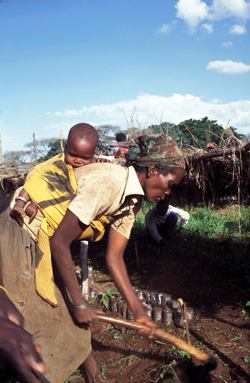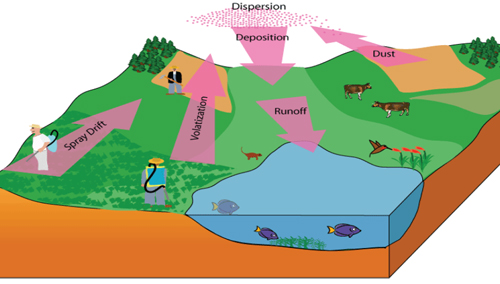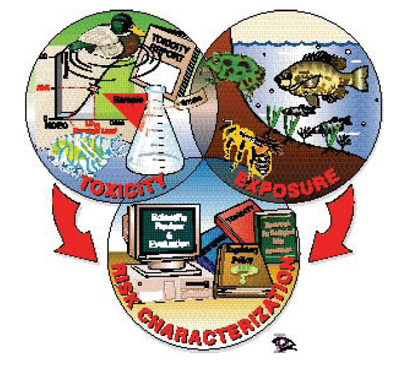|
|
Vol.
35 No. 4
July-August 2013
by Ronald Parker
Worldwide demand for food is growing due not only to increasing population, but also because higher percentages of the population in several large economies (e.g., BRICKS* and other rapidly growing countries) now have incomes that allow them to move beyond subsistence foods and demand fruits, vegetables and meats that were not possible in the recent past. As a result, the extent of land devoted to export-driven agriculture is also growing.
One side-effect of increasing agricultural production is a need for increased use of crop protection chemicals and with this, an awareness of the need to evaluate the impact of additional pesticide use. This need includes not only meeting maximum pesticide residue limits (MRLs) in export food commodities, but also protecting the natural environment in these newly agriculturalized regions.
 |
Figure 1: Crops grown in subsistence
agricultural systems are largely
consumed locally. |
The eValuate pesticide ecological risk assessment training materials respond to this need by providing a streamlined collection of methods, modeling tools, process descriptions, and terminology that can be used to evaluate the potential ecological risk of pesticide usage in an agricultural environment. This online module provides instruction in the risk assessment process and describes the process of evaluating pesticide environmental fate and transport information combined with laboratory toxicity data to provide an indication of potential ecological risk. The eValuate module is a medium to help risk assessors learn how to conduct and use the process of ecological risk assessment to help manage hazards and risks of pesticide use. It also includes valuable information, training materials, reference sources, and instructions on safe use and disposal of pesticides.
All countries require pesticidal products, not only to sustain public health and well being, but also to protect crops from damage inflicted by insects and fungi and competition from weeds. Maintaining safe use of pesticides, however, necessitates that governments have a procedure to evaluate and approve (or disapprove) the pesticides that are used within their borders. Land-extensive agricultural systems present a different level of risk than subsistence agriculture in which most food is grown and consumed locally.
Newly developing countries experience a unique set of difficulties in performing risk assessments for pesticide registration. These difficulties often include: (1) too few experienced, professional staff, (2) high rates of personnel turnover and frequent need to train new staff, (3) inadequate laboratory facilities, (4) limited data on local species that most require official protection, (5) limited access to the chemical-specific environmental fate and toxicity data that are required to evaluate risk, and (6) lack of the data on local soils, water resources, and climatic zones that are needed to describe the areas that require protection. These difficulties have impeded all but a limited number of countries from regularly carrying out the detailed assessments that are needed to manage the risk of pesticide usage. Figure 1 and 2 depict the scale of the change that is occurring.
Recognizing these difficulties, the Organization for Economic Cooperation and Development (OECD), Working Group on Pesticides (WGP) initiated an International Pesticide Assessment Consultation held in Washington, D.C., in October 1998. Hosted jointly by the U.S. Environmental Protection Agency’s Office of Pesticide Programs (OPP) and the National Chemicals Inspectorate of Sweden, the consultation had several objectives.
- To develop recommendations for how countries can work together better to share the work of pesticide risk assessments and, in doing so, consider how national or regional pesticide data review reports can be used most effectively.
- To review the roles of national governments, intergovernmental organizations and non- governmental organizations in international cooperation on pesticide risk assessments and standard setting.
- To discuss the most effective means of disseminating pesticide assessment information to countries, considering existing methods and availability of resources.
The WGP consultation also made recommendations that were relevant to deciding what to include in the eValuate module:
- establish a list of websites containing useful information on pesticides, and distribute it widely
- include a brief description of the most useful websites, along with some indication of the quality and currency of the information
- encourage countries without access to the Internet to gain access by seeking assistance from developed countries
- develop and disseminate a list of terminology definitions
- look for opportunities to build regional networks, for information sharing or for developing coordinated regulatory systems
- encourage national governments to coordinate pesticide reevaluations schedules to allow for timely work sharing
- promote the idea of holding regional workshops on a regular basis in order to promote harmonization and to assist countries with less-developed pesticide risk management processes
iStock_000000127525_L2.jpg) |
| Figure 2: Much of the agricultural production in land-extensive agriculture enters into international trade. |
In responding to the WGP proposal and to requests from developing countries, especially in Latin America, for assistance in ecological risk assessment of pesticides, the OPP provided funding for completion of a comprehensive risk assessment and training module based in large part on the methods used by OPP. The OPP module project was initiated in 2002 and developed through a contract with the Oak Ridge National Laboratory (ORNL) in Oak Ridge, Tennessee, in cooperation with OPP. Development of the the first draft versions of the eValuate module in English and in Spanish were completed by ORNL. The final version of eValuate went through final quality assurance/quality control review by the OPP Environmental Fate and Effects Division. The final versions include the extensive glossary, list of definitions, and process descriptions developed by IUPAC in both English and Spanish (see IUPAC project 2004-002-1-600; PAC 2006, Vol. 78, No. 11, pp. 2075-2154; http://dx.doi.org/10.1351/pac200678112075).
| Newly developing countries experience a unique set of difficulties in performing risk assessments for pesticide registration. |
Other cooperators in this project have included the IUPAC Division VI –Chemistry and the Environment Division- Subcommittee on Crop Protection Chemistry, the Food and Agriculture Organization (FAO) Plant Production and Protection Division, the FAO/International Atomic Energy Agency Joint Division for Agriculture, and the OPP Field and External Affairs Division and Environmental Fate and Effects Division (see IUPAC projects 2004-011-1-600 and 2008-011-2-600).
The first drafts of this module recommended use of a relative (comparative) risk assessment paradigm primarily for the advantages it would offer in aquatic exposure assessment. This paradigm offers the advantage that the results of the assessment are independent of the physical configuration assumptions for the assessment scenario (i.e., land to water ratios chosen, soil and weather selected, and timing of pesticide used in relation to important weather events). The relative risk methodology was eventually dropped due to difficulties in integrating the comparative risk results with those of other national and multinational assessment schemes.
The module is designed to provide a step-by-step process for conducting an evaluation of ecological risks of pesticide use. The module includes guidance through the risk assessment/risk management process, OECD-compatible data handling, a glossary of pesticide terms and process descriptions, and links to exposure assessment computer models with use instructions, lists of international pesticide websites, and pesticide targeted risk management options. eValuate also provides access to a number of readily-available, easy-to-use assessment simulation tools for carrying out aquatic and terrestrial pesticide ecological exposure/risk assessments. These methodologies and tools can assist countries in making science-based decisions regarding the use and management of pesticides.
A workshop for field testing of EPA’s Risk Assessment and Training Module was held at the headquarters of the Central American Commission for Environment and Development in San Salvador, El Salvador, 15–16 November 2004. The meeting was hosted and sponsored by the Commission and the U.S. Agency for International Development and was attended by 18 representatives of ministries of environment, agriculture, and health involved in the evaluation and registration of pesticides in Central America. Participants in the session represented the governments of El Salvador, Guatemala, Nicaragua, Costa Rica, Belize, Panama, and Honduras. A progress report on development of the module was made at the International Workshop on Crop Protection Chemistry in Latin America—Harmonized Approaches to Environmental Assessment and Regulation, held in San Jose, Costa Rica, in February 2005 (see July 2005 CI, www.iupac.org/publications/ci/2005/2704/cc1_140205.html).
The training module and tools are organized into the following seven sections:
Section 1: Introduction to Pesticide Ecological Risk Assessment
Section 2: Components of Pesticide Ecological Risk Assessment
Section 3: Pesticide Ecological Risk Assessment Models and Databases
Section 4: Ecological Risk Estimation and Characterization
Section 5: Pesticide Risk Management/Regulatory Activities
Section 6: Training Materials, Presentations, Example Training Class Schedule, Example Pesticide
Section 7: International Websites, Useful Historical References, Glossaries, Common Acronyms, and Units
Together, these seven sections of the module provide descriptions of methods, processes, procedures, and tools that can be used to carry out both aquatic (fish, amphibians, etc.) and terrestrial (birds, mammals, reptiles, etc.) ecological risk assessments. Methods and tools are designed to be, as much as possible, the same as, or compatible with those used in the USA and Canada.
Figure 3, here, is a visual representation of the methodology used in eValuate. The diagram depicts the process of balancing potential risks with the estimated benefits derived from usage of a specific pesticide. The benefits section is included to provide a complete picture of the assessment process followed by the U.S. EPA. The eValuate module does not describe the process of evaluating benefits or of evaluating risk to human health.
 |
| Figure 4. Physical diagram of ecological exposure assessment. |
Ecological risk is characterized in the natural field context within which the pesticide is used. Figure 4, above, is a presentation of the context of a pesticide risk assessment. Characterizing the ecological risk is a process of comparing an estimated ecological concentration with a laboratory toxicity concentration. If the exposure concentration exceeds the concentration shown in the laboratory to be toxic, some level of risk may be assumed. See figure 5 below.
 |
Figure 5. Comparison of pesticide exposure to
pesticide toxicity as a means of characterizing potential risk.2 |
Ecological exposure is estimated independently for aquatic animals and plants and for terrestrial animals and plants. Concentration values for each of these categories are estimated through a combination of field data collection and computer-simulation modeling. The two approaches used together have a synergy in which each compliments the other. With concentrations of more than 400 pesticides changing day-to-day and year-to-year, the cost of monitoring by itself is prohibitive. Computer simulation on the other hand, while it permits estimation of daily concentration values at many selected sites quickly and easily, has little value if the concentration values are not grounded in a known field reality. Monitored values, if collected with sufficient frequency and with contextual data, can be used to provide data points in time and in space that can be used directly in risk assessments, and possibly more important, may be used to develop, validate, and calibrate simulation models. Simulation models can be used to interpolate between and extrapolate beyond measured data points both in space and in time. Each method feeds the other in a way that enhances predictive ability far beyond the capacity of either one by itself.
Both Canada and the USA use the linked Pesticide Root Zone Model (PRZM) and Exposure Analysis Modeling System (EXAMS) developed by the EPA’s Office of Research and Development. OPP is currently completing final quality control on a user-friendly method to perform PRZM/EXAMS assessments. This technology has the potential to enable regulators in developing countries to conduct complex aquatic pesticide assessments.
The PRZM model requires data on local crops, soils, topography, and weather. Collecting this data is labor intensive. Such data is typically available from national governments and through international organizations (FAO, UNEP, etc.). Data may be organized through work already completed on ecological regions.
Terrestrial wildlife exposure estimates conducted by the EPA/OPP are calculated for birds and mammals, emphasizing a dietary exposure route for uptake of pesticide active ingredients. These exposures are considered as surrogates for terrestrial-phase amphibians as well as reptiles. For exposure to terrestrial organisms, risk assessors primarily look at the residues of pesticides on food items and assume that organisms are exposed to a single pesticide residue in a given exposure scenario. Two approaches are used for estimating exposure to terrestrial wildlife, which are dependent on the application method: (1) spray applications and (2) granular, bait, and treated-seed applications. It should be noted that, although the screening-level, terrestrial-wildlife risk assessment focuses, in large part, on dietary exposure, risk assessors do consider the relative importance of other routes of exposure in situations where data indicate that pesticide exposures through routes other than dietary may be potentially significant contributors to wildlife risk.
For spray applications, estimation of pesticide concentrations in wildlife food items focuses on quantifying possible dietary ingestion of residues on vegetative matter and insects. The residue estimates are based on a nomogram that relates food-item residues to pesticide application rate. The nomogram is based on an EPA database called UTAB (Uptake, Translocation, Accumulation, and Biotransformation), a compilation of actual measured pesticide residue values on plants (see references 3 and 4).
www.iupac.org/project/2008-011-2-600
- Guidelines for Ecological Risk Assessment, US Environmental Protection Agency, April 1998. http://www.epa.gov/raf/publications/pdfs/ECOTXTBX.PDF
- Science Policy Council Handbook Risk Characterization, US Environmental Protection Agency, December 2000. http://www.epa.gov/spc/pdfs/rchandbk.pdf
- Hoerger, F. and E.E. Kenaga. 1972. Pesticide residues on plants: correlation of representative data as a basis for estimation of their magnitude in the environment. IN: F. Coulston and F. Corte, eds., Environmental Quality and Safety: Chemistry, Toxicology and Technology. Vol 1. George Theime Publishers, Stuttgart, Germany. pp. 9-28.
- Fletcher, J.S., J.E. Nellesson and T. G. Pfleeger. 1994. Literature review and evaluation of the EPA food-chain (Kenaga) nomogram, an instrument for estimating pesticide residues on plants. Environ. Tox. And Chem. 13(9):1383-1391.
Dr. Ronald Parker <[email protected]> works at the U.S. Environmental Protection Agency Office of Pesticide Programs in Washington, D.C. He is a member of IUPAC Division VI–Chemistry and the Environment Division, Subcommittee on Crop Protection Chemistry.
Page
last modified 29 August 2013.
Copyright © 2003-2013 International Union of Pure and Applied Chemistry.
Questions regarding the website, please contact [email protected]
|